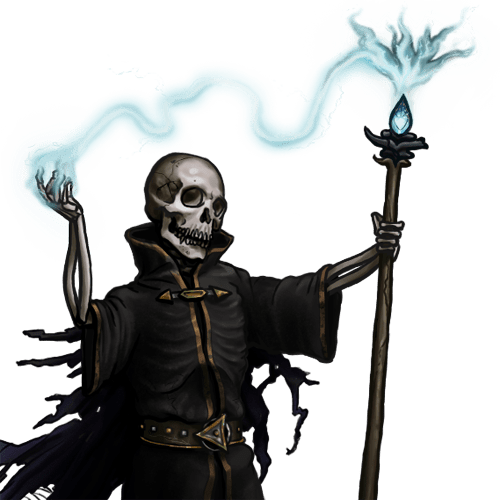
In modern fantasy fiction, a lich (![]() /ˈlɪtʃ/; sometimes spelled liche, cognate to Dutch lijk and German Leiche, both meaning “corpse”) is a type of undead creature. Often such a creature is the result of a transformation, as a powerful magician or king striving for eternal life uses spells or rituals to bind his intellect to his animated corpse and thereby achieve a form of immortality. Liches are depicted as being clearly cadaverous, their bodies desiccated or even completely skeletal. Liches are often depicted as holding power over hordes of lesser undead creatures, using them as soldiers and servants.
/ˈlɪtʃ/; sometimes spelled liche, cognate to Dutch lijk and German Leiche, both meaning “corpse”) is a type of undead creature. Often such a creature is the result of a transformation, as a powerful magician or king striving for eternal life uses spells or rituals to bind his intellect to his animated corpse and thereby achieve a form of immortality. Liches are depicted as being clearly cadaverous, their bodies desiccated or even completely skeletal. Liches are often depicted as holding power over hordes of lesser undead creatures, using them as soldiers and servants.
Unlike zombies, which are often depicted as mindless, part of a hivemind and/or under the control of some magician, a lich retains independent thought and is usually at least as intelligent as it was prior to its transformation. In some works of fiction, liches can be distinguished from other undead by their phylactery – an item of the Lich’s choosing into which they imbue their soul, giving them immortality until the phylactery is destroyed.
Various works of fantasy fiction, such as Clark Ashton Smith‘s “Empire of the Necromancers,” had used lich as a general term for any corpse, animated or inanimate, before the term’s specific use in fantasy role-playing games. The more recent use of the term lich for a specific type of undead creature originates from the 1976 Dungeons & Dragons role-playing game booklet Eldritch Wizardry, written by Gary Gygax and Brian Blume.
In literature
The lich developed from monsters found in earlier classic sword and sorcery fiction, which is filled with powerful sorcerers who use their magic to triumph over death. Many of Clark Ashton Smith‘s short stories feature powerful wizards whose magic enables them to return from the dead. Several stories by Robert E. Howard, such as the novella Skull-Face and the short story “Scarlet Tears,” feature undying sorcerers who retain a semblance of life through mystical means, their bodies reduced to shriveled husks with which they manage to maintain inhuman mobility and active thought. Gary Gygax, one of the co-creators of Dungeons & Dragons, stated that he based the description of a lich included in the game on the short story “The Sword of the Sorcerer” by Gardner Fox. The term lich, used as an archaic word for corpse (or body), is commonly used in these stories. H.P. Lovecraft also used the word in “The Thing on the Doorstep” (published 1937) where the narrator refers to the corpse of his friend which was possessed by a sorcerer. Other imagery surrounding demiliches, in particular that of a jeweled skull, is drawn from the early Fritz Leiber story “Thieves’ House.”
An earlier mention of the lich can be found in “The Death of Halpin Frayser,” a short story by Ambrose Bierce. Halpin Frayser is found dead with a poem written in the style of Myron Bayne, his maternal great-grandfather. Through investigation and flashbacks, the reader finds that Frayser becomes possessed by Myron Bayne, a distant ancestor, who senses that a lich named Catharine Larue has risen from her grave to kill Frayser. Myron Bayne takes possession in order to finish one last poem before Frayser’s death. At the end of the story, the men investigating the murder conclude that Catharine Larue was Frayser’s heartbroken mother, who had died some time before the murder. Bierce describes liches thus: “For by death is wrought greater change than hath been shown. Whereas in general the spirit that removed cometh back upon occasion, and is sometimes seen of those in flesh (appearing in the form of the body it bore) yet it hath happened that the veritable body without the spirit hath walked. And it is attested of those encountering who have lived to speak thereon that a lich so raised up hath no natural affection, nor remembrance thereof, but only hate. Also, it is known that some spirits which in life were benign become by death evil altogether.”
Liches in Dungeons & Dragons
Main article: Lich (Dungeons & Dragons)
In the Dungeons & Dragons game (and other works of fantasy fiction that draw upon Dungeons & Dragons for inspiration), a lich is often a spellcaster or someone assisted by a spellcaster who seeks to defy death by magical means. They are necromancers who are unsatisfied with the level of power that they currently have, wish for longer lives, and seek to unburden themselves from the necessities of bodily functions (such as eating and sleeping) so that they might dedicate every moment of their existence to the attainment of knowledge and power. There have also been descriptions of highly powerful spellcasters that force the conversion on mighty creatures to wreak havoc. Liches convert themselves into undead creatures by means of black magic, storing their souls in magical receptacles called phylacteries, leaving their bodies to die and wither. With their souls bound to material foci, they can never truly die. If its body is destroyed, a lich can simply regenerate or find a new one. According to the Dungeons & Dragons mythos, the only way truly to destroy a lich is first to destroy its phylactery, thereby removing its anchor to the material world, and then to destroy its physical form. The phylactery can be an object of any kind. They can range from a simple knife to a treasure, like a jeweled goblet. The most common type of phylactery is a gem with a wide variety of colors.